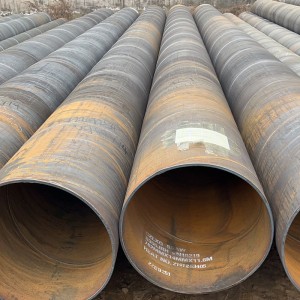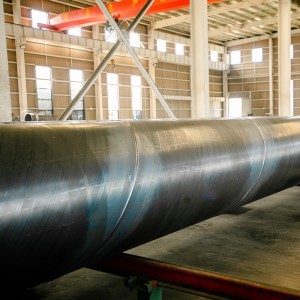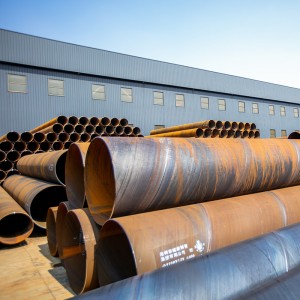Advantages Of Cold Formed Welded Structural
Cold formed steel is produced by bending and forming steel sheets or coils at room temperature without the use of heat. The process produces a stronger, more durable material than hot-formed steel. This cold-formed steel offers several key advantages when welded together to form structural components.
|
Standard |
Steel grade |
Chemical composition |
Tensile properties |
Charpy Impact Test and Drop Weight Tear Test |
||||||||||||||
| C | Si | Mn | P | S | V | Nb | Ti | CEV4)(%) | Rt0.5 Mpa Yield strength | Rm Mpa Tensile Strength | Rt0.5/ Rm | (L0=5.65 √ S0 )Elongation A% | ||||||
| max | max | max | max | max | max | max | max | Other | max | min | max | min | max | max | min | |||
| L245MB |
0.22 |
0.45 |
1.2 |
0.025 |
0.15 |
0.05 |
0.05 |
0.04 |
1) |
0.4 |
245 |
450 |
415 |
760 |
0.93 |
22 |
Charpy impact test: Impact absorbing energy of pipe body and weld seam shall be tested as required in the original standard. For details, see the original standard. Drop weight tear test: Optional shearing area |
|
|
GB/T9711-2011(PSL2) |
L290MB |
0.22 |
0.45 |
1.3 |
0.025 |
0.015 |
0.05 |
0.05 |
0.04 |
1) |
0.4 |
290 |
495 |
415 |
21 |
|||
| L320MB |
0.22 |
0.45 |
1.3 |
0.025 |
0.015 |
0.05 |
0.05 |
0.04 |
1) |
0.41 |
320 |
500 |
430 |
21 |
||||
| L360MB |
0.22 |
0.45 |
1.4 |
0.025 |
0.015 |
1) |
0.41 |
360 |
530 |
460 |
20 |
|||||||
| L390MB |
0.22 |
0.45 |
1.4 |
0.025 |
0.15 |
1) |
0.41 |
390 |
545 |
490 |
20 |
|||||||
| L415MB |
0.12 |
0.45 |
1.6 |
0.025 |
0.015 |
1)2)3 |
0.42 |
415 |
565 |
520 |
18 |
|||||||
| L450MB |
0.12 |
0.45 |
1.6 |
0.025 |
0.015 |
1)2)3 |
0.43 |
450 |
600 |
535 |
18 |
|||||||
| L485MB |
0.12 |
0.45 |
1.7 |
0.025 |
0.015 |
1)2)3 |
0.43 |
485 |
635 |
570 |
18 |
|||||||
| L555MB |
0.12 |
0.45 |
1.85 |
0.025 |
0.015 |
1)2)3 | Negotiation |
555 |
705 |
625 |
825 |
0.95 |
18 |
|||||
| Note: | ||||||||||||||||||
| 1)0.015 ≤ Altot < 0.060;N ≤ 0.012;AI—N ≥ 2—1;Cu ≤ 0.25;Ni ≤ 0.30;Cr ≤ 0.30;Mo ≤ 0.10 | ||||||||||||||||||
| 2)V+Nb+Ti ≤ 0.015% | ||||||||||||||||||
| 3)For all steel grades, Mo may ≤ 0.35%, under a contract. | ||||||||||||||||||
| Mn Cr+Mo+V Cu+Ni 4)CEV=C+ 6 + 5 + 5 | ||||||||||||||||||
One of the main advantages of cold formed welded structural steel is its high strength-to-weight ratio. This means it provides superior strength while being relatively lightweight, making it easier to handle and transport during construction. Additionally, the high strength of cold-formed steel enables slender and efficient structural designs that maximize space and reduce material use.
Another significant advantage of cold-formed welded structural steel is its uniformity and consistency. The cold forming process ensures that the steel maintains consistent mechanical properties throughout the material, resulting in predictable and reliable performance. This consistency is critical to ensuring the structural integrity and safety of the final construction.

In addition to strength and consistency, cold Formed Welded Structural steel offers excellent dimensional accuracy and precision. The cold forming process allows for tight tolerances and precise molding, ensuring the structural components fit together seamlessly during assembly. This level of precision is critical to achieving a high-quality, visually appealing finished product.
Additionally, cold Formed Welded Structural steel is versatile and can be customized to meet specific project requirements. It can be easily shaped and formed into a variety of contours and configurations, allowing the creation of complex structural designs. This versatility makes it suitable for a wide range of applications from residential construction to industrial facilities.
The use of cold Formed Welded Structural steel also contributes to sustainable building practices. Its lightweight nature reduces the overall load on the foundation and support structure, resulting in potential cost savings and environmental benefits. Additionally, steel’s recyclability makes it an environmentally friendly choice for construction projects.
In summary, cold Formed Welded Structural steel offers numerous advantages that make it an attractive choice for construction projects. Its high strength-to-weight ratio, consistency, precision, versatility and sustainability make it a valuable material for creating durable, efficient structures. As the construction industry continues to evolve, cold Formed Welded Structural steel will play an important role in shaping the buildings and infrastructure of the future.








